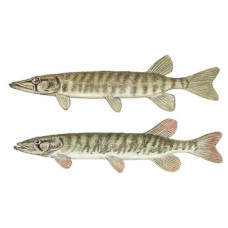Latin name
Esox americanus vermiculatus, Esox americanus americanus
Other names
Banded pickerel, little pickerel, mud pickerel.
Identification
Thin and cylindrical, grass and redfin pickerel look very similar to chain pickerel, with the same fully scaled cheeks and gill covers. They are dark olive, brown or black on top, amber or coppery white underneath, with 20 or more dark green or brown wavy stripes on the sides. Grass pickerel have pale areas between the stripes that are wider than the stripes. The grass pickerel is lighter than the redfin pickerel and has a distinct pale central lateral stripe. The grass pickerel also has yellow-green or dusky lower fins and a long, narrow snout (though shorter than the chain pickerel) with a concave profile, while the redfin pickerel has red lower and caudal fins and a shorter and wider snout with a convex profile. Each has a large mouth with sharp fangs and several sensory pores on the lower jaw. A dark vertical band runs down from each eye, which is more vertical in the grass pickerel than in the redfin pickerel. An easy way to tell redfin from grass pickerel is to look at the scales on the sides of the redfin, which are more serrated or heart-shaped, with six in the area between the pelvic fins. The grass pickerel has no more than three. In addition, the redfin has more than seven such scales between the dorsal and anal fins, while the grass pickerel has four or fewer.
Distribution
In North America, the grass pickerel is distributed from the Great Lakes basin north to southern Ontario in Canada and as far north as Michigan, Wisconsin, and Nebraska. It is also found in the Mississippi River and Gulf Slope drains west of the Pascagoula River in Mississippi to the Brazos River in Texas. Redfin pickerel are found in Atlantic slope drains from the St. Lawrence River in Quebec to South Georgia, and they are also found in Gulf slope drains from the Pascagoula River in Mississippi to Florida. Populations of both species are usually small locally.
Habitat
Grass and redfin pickerel inhabit quiet or small lakes and marshes, bays and creeks, and sluggish stream pools. Both prefer dense vegetation in clear waters, but the grass pickerel prefers waters with neutral or basic acidity, and the redfin pickerel lives in relatively acidic waters.
Size
Both species rarely exceed 10 inches in length (redfin pickerel can reach 14 inches) and three-quarters of a pound in weight. The redfin pickerel tends to grow faster and is slightly longer than the grass pickerel. The world record for grass pickerel is 1 pound caught in Indiana. The record for Redfin Pickerel is 1 pound 15 ounces from New York. They can live up to 8 years, although they usually live 5 years or less. Females live longer and grow larger than males.
Life history and Behavior
Reaching sexual maturity at about 2 years old and at least 5 inches long, grass and redfin pickerel spawn in late fall, early winter, or spring. The grass pickerel requires water temperatures of 36° to 54°F, and the redfin pickerel prefers water temperatures around 50°F. Spawning occurs in heavily vegetated shallow water, with the backs of the fish appearing at the surface as they scatter eggs in small batches over the vegetation. Grass pickerel can produce twice as many eggs as redfin pickerel. They do not nest. Grass pickerel eggs hatch in 11-15 days, redfin pickerel in 12-14 days, without parental protection.
Food and feeding habits
Grass and redfin pickerel feed primarily on other fish such as minnows, although they will occasionally eat aquatic insects, small crustaceans, and frogs. They can remain virtually motionless among the vegetation for several hours, waiting to surface and take potential food.
Reproduction
No information
| Classification | |
| Phylum | Chordata |
| Class | Actinopterygii |
| Squad | Esociformes |
| Family | Esocidae |
| Genus | Esox |
| Species | E. americanus |
| Features | |
| Conservation status | Least Concern |
| Habitat | Pelagic |
| Life span, years | 8 |
| Maximum body weight, kg | 0.91 |
| Maximum length, cm | 33 |
| Sailing speed, m/s | No information |
| Threat to people | Edible |
| Way of eating | Predator |
Grass pickerel, Redfin pickerel
Tags: Grass pickerel, Redfin pickerel



